Written by CPM Magazine from CPM Magazine
Download PDF
After successive years where March has seen the ground begin to dry out after the winter downpours, 2023 appears to have bucked the trend. CPM met up with the Bayer Crop Doctor team to survey sites around the country and get a feel for the possible disease challenges ahead.
By Lucy de la Pasture and Janine Adamson
The spring equinox often marks the time when winter wheat crops go into stem extension, triggering the first fungicide application of the season in crops where a T0 is merited. In 2023, above average March rainfall may have put things on hold until the ground can travel.
While that’s not a disaster in wheat crops which aren’t battling yellow rust, it has the potential to compromise the best laid fungicide plans in winter barley and oilseed rape crops.
Long Sutton, Lincolnshire
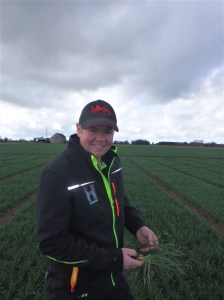
Yellow rust would normally be evident in crops by now but David Hoyles says two sharp frosts recently, which is unusual at Long Sutton, has probably helped subdue infection.
Kicking off Crop Doctor for the season saw the team visit David Hoyles’ farm at Long Sutton, Lincolnshire on 21 March. On first inspection, all plots looked much further ahead than expected given the 15 October drilling date, although perhaps not so unusual for David’s crops which tend to get away quickly in the spring.
Leading the assessment was ADAS’ Jonathan Blake, who attributes this progression to the mild autumn growers experienced. “The crop plots looks like they were drilled a fortnight earlier, and while the canopies looks healthy, there’s a lot of septoria already present on lower leaves,” he says.
“There’s a sea of inoculum across all varieties, even KWS Extase, which is commended for its resistance package. It’s not surprising given the forward nature of the plants – they’re behaving in a similar way to early drilled crops.
“We’d expect plant genetics to show through soon because varietal disease ratings are based on adult plants, not juveniles. But the severity in any given variety will also depend on the weather.”
The weather’s certainly been a challenge for David recently, who’s awaiting a dry spell and for the ground to dry up. “We had a dry December through to February, then a very wet March [equal to the sum of rainfall over the winter months], and now it looks like another fortnight of rain,” he says. “I’m hoping the crop can handle it though, given it grew up and away so quickly in the autumn.”
Diving into the specific varieties, comments continue to be septoria-themed. “Yes, a lot of septoria and also some stem-based browning, although it’s too early to identify the cause but eyespot would be a strong possibility,” comments Jonathan, while stood in a plot of Graham.
Having found septoria in every variety, it was two tiny orange-brown lesions in the Crusoe that created chatter among the Crop Doctor team. “That looks like brown rust to me, although the site is surprising clean of yellow rust,” says Jonathan.
“We’d usually see yellow rust by now but we had two sharp frosts recently, which is unusual for us and it has probably helped,” adds David.
Jonathan warns him not to become complacent. “Right now, we have perfect yellow rust conditions so although it’s been knocked back, it’s likely to bounce back too. These damp conditions will also have an impact for our current septoria problem. When we return in around four weeks, I’d expect a sea of septoria.”
Conversation soon switches to the farm’s fungicide programme. David acknowledges the need to ‘get on’ and be timely, but has struggled with continual rain. “We’ve missed T0 in some fields, but might consider a T0.5 of something relatively cheap and cheerful if we can, based on tebuconazole and a strobilurin.
“It all depends on the risk, if it’s high I’ll go with Ascra Xpro (bixafen+ fluopyram+ prothioconazole), but if not, I’ll stick with the cheaper option. The crops are looking the best they’ve looked for four years, so we don’t want disease to take over.”
Aside from fungicides, David’s also planning a PGR spray and further micronutrition, which began earlier in the season. For nitrogen, the farm’s average is 180kg/ha.
Going through the Bayer variety plots one final time, Jonathan notes the onset of mildew. “It can be an issue for varieties such as Crusoe, KWS Zyatt and Skyfall at T0. However, my main ‘watchouts’ from today are septoria and yellow rust. The mild wet autumn has promoted the septoria and current conditions are suited to yellow rust which, as this region is particularly prone, I’d expect to bounce back from the recent frosts.
“Given the autumn weather, growers will have to manage their expectations on varietal disease ratings, and knock them back by around 0.5, as these crops will be more septoria prone.”
Boghall Farm, Midlothian
Dodging heavy showers, the Scottish Crop Doctor team report septoria as the main finding in the Bayer variety demo plots at SRUC’s Boghall Farm, just outside Edinburgh.
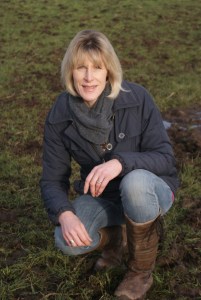
Fiona Burnett says T1s will have to do a decent job with higher disease levels to contend with this year, but adds that it actually makes decision making easier than in a low disease pressure season.
“There are no huge differences between the 20 varieties here, all have septoria on the lower leaves with active pycnidia. But where there are differences, these are related to the growth habit and it’s the varieties with a prostrate habit that have the most septoria,” comments Prof Fiona Burnett, plant pathologist at SRUC.
“Where the leaves lie flat to the ground, the septoria is more easily spread by rain splash,” she adds.
According to Bayer’s Grant Reid, the varieties at the demo site are behind most commercial crops in the area, where septoria levels are more rampant. Fiona chimes in that the early drilling last autumn, August in places, followed by a warm autumn, a cold and dry spell early in the new year and then relentless rain through March has laid the foundations for a higher septoria season than has been seen in a number of years.
“In commercial crops, LG Illuminate stands out as a growthy variety that’s carrying high levels of septoria. There’s also stem-based browning evident this spring but whether it develops into eyespot or not, time will tell,” says Grant.
Fiona agrees that eyespot may be an issue this year. “Early drilling and the relatively warm weather we’ve had are both drivers for the disease.”
Even though the plots at Boghall are a little behind, Grant notes the varieties have a good number of tillers so the potential is there and they should soon rocket on.
In winter barley, there’s more disease evident than there has been for a few years, with rhynchosporium, net blotch and mildew all easy to find, he adds.
“When the weather improves, the pressure will be on growers to get fertiliser and early fungicides on so they’ll have to prioritise. In winter barley, the T0 timing may be missed if the ground won’t travel as crops will rush through the growth stages now.”
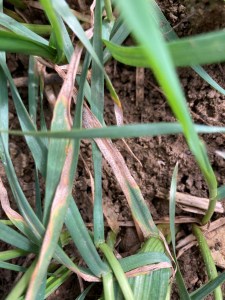
Some varieties are carrying higher levels of septoria than might be expected, but adult plant resistance won’t have kicked in yet.
Fiona believes it won’t be a year to scrimp on fungicides. “The expense of growing crops currently means getting disease protection on is a no brainer,” she says. “After all the March rainfall, T1s will have to do a decent job with higher disease levels to contend with this year. But it actually makes decision making easier than in a low disease pressure season.”
She advises keeping diversity in the fungicide programme – for wheat that means looking ahead at T2 and adopting different chemistry at T1. “Where there’s eyespot, there’s a good case for prothioconazole plus an SDHI at T1. Folpet inclusion also helps disease control, resistance management and adds yield.”
The OSR at Boghall has reached stem extension, getting away from pigeons which have been problematic this year, says Grant. There is also unusual levels of disease to contend with. “We’re seeing increasing levels of light leaf spot (LLS) and phoma in crops from the Borders northwards from the results of SpotCheck sampling. Thre haven’t been any real issues with pests, though slugs have been active, and crops are well rooted so will romp away.”
Fiona reckons there’s a distinct risk they could become too tall if growers aren’t mindful.
On a positive note, Grant says the moisture in the ground will help spring barley crops get away quickly and they’re unlikely to be short of water in those early weeks where tilering is so crucial. It’s also likely that pre-emergence herbicides will work well too, giving growers one less thing to worry about where annual meadowgrass is a problem, he adds.
Great Tew, Cotswolds
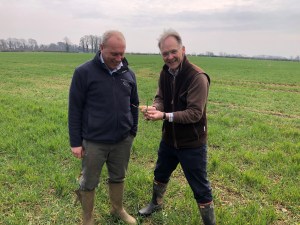
Jonathan Blake and Colin Woodward assess disease levels in the commercial crops at the Great Tew Estate.
At the Great Tew Estate, farm manager and agronomist, Colin Woodward, is also grounded due to the March rainfall. Like David Hoyles, the rainfall in March – 63mm to date (22 March) – equals the quantity that fell through the depths of winter.
Again, it’s septoria that’s the biggest cause for concern in the commercial crops, with visible lesions on the lower leaves of all Colin’s winter wheat varieties, even those with high resistance ratings. “The symptoms we’re seeing now are from septoria infection that would have been in its latent phase in January-February. The effect of the March rainfall will be showing up when we visit again next month.”
Walking into a crop of mid-October sown LG Skyscraper, Jonathan isn’t surprised to see the levels of septoria its carrying on the lower leaves. However, the crop of nearby KWS Palladium does raise a few eyebrows.
“Palladium is rated 7.4 for septoria resistance but its currently looking very similar to the Skyscraper we’ve just been in, with more septoria than I’d expected,” says Jonathan. Popping into another field of KWS Extase, it tells a similar tale – septoria lesions are very evident on the oldest leaves.
He goes on to explain that the AHDB Recommended List ratings are for adult plant resistance, which is assessed in June and July. “Varieties differ with how they pick up disease over the winter, during the seedling phase septoria resistance may not have kicked in.”
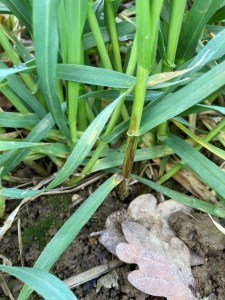
Stem-based browning is easy to find in KWS Extase at all the Crop Doctor sites spanning the country and at Great Tew, the lesions are found much higher on the stem (pictured).
A second field of Extase, drilled at the end of October after peas, proves to be much cleaner as far as septoria is concerned but here, stem-based browning is Jonathan’s stand out observation. “The browning is higher on the stem than I’d expect – where the fifth or sixth last leaf to emerge is dying back. Some of the lesions are penetrating,” he comments.
Also after peas and later drilled, Colin’s field of Champion is looking good and relatively clean. Nearby KWS Dawsum is standing very erect, with residual septoria in the base but very little on the last leaf emerged.
Moving into a crop of SY Kingsbarn winter barley, there’s a full house of foliar diseases in the more fertile patches, with brown rust and net blotch of most concern.
Bayer’s Ben Giles says it seems to be a net blotch year and warns growers to keep an eye on spring barley because of the danger of high seed infection levels. “It’s a disease that can prove more difficult to control now [due to fungicide insensitivity] so it’s best to used a mix of chemistry and keep rates up,” he advises.
Asked about his fungicide plans, Colin says no fungicide is planned for the winter wheat as all his varieties have an RL rating of 7 or above for yellow rust, which isn’t evident in the crop at the moment. PGRs, trace elements and herbicide, where required, will go on as a T0 at the end of March/early April.
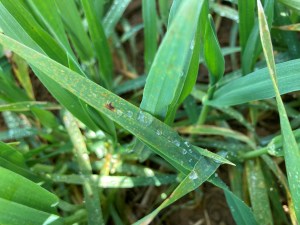
Although there’s a full house of foliar diseases to be found on SY Kingsbarn at Great Tew, it’s net blotch and brown rust that are the primary concerns at the moment.
“If the wet weather continues then I’ll look to increase fungicides at T1. I haven’t yet decided between Aviator (bixafen+ prothioconazole) or Ascra (bixafen+fluopyram+ prothioconazole) for the Extase. Aviator has a higher loading of prothioconazole to tackle any eyespot,” he adds.
Folpet is likely be added to the T1 mix in the more disease prone varieties, such as Skyscraper, and where the barley is ‘stressy’ to aid ramularia control.
But it’s the winter barley and OSR that will take priority at Great Tew. “The Kingsbarn will have a T0 of Prosaro (prothioconzole+ tebuconazole) to help with the net blotch.”
LLS is also making an appearance in Colin’s Matrix OSR crop, and Ben notes the Bayer SpotCheck service has been seeing high incidences of LLS in samples over the past two months. Colin is planning to apply a PGR – Caryx (mepiquat-chloride+ metconazole) or Toprex (difenoconazole+ paclobutrazol) – with tebuconazole or Prosaro plus trace elements when the ground will travel, followed by prothioconazole and a strobilurin at early flowering.
Callow, Herefordshire
After 5mm of overnight rain, the heavy ground at Callow – just south of Hereford – has done a pretty good job of mopping up the 70mm that has fallen so far in the month (to 22 March). Water is sitting in the tramlines but a strong gusty wind is doing its best to dry the soil.
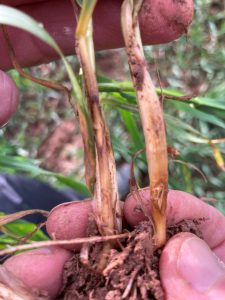
At Callow in Herefordshire, eyespot lesions are penetrating in places in KWS Extase.
This year the Bayer demo site is in one of the lower lying fields on the farm and developmental differences are showing up in the plots, which comprise 38 varieties and three blends, drilled 13 October, explains Bayer’s Gareth Bubb.
A quick overview of the plots reveals the most backwards looking varieties, which include RGT Grouse, LG Typhoon and LG Arkle, whereas leading the charge into spring are KWS Extase and Bamford.
Joined by Herefordshire-based independent agronomist David Lines, Jonathan heads towards ‘indicator’ varieties and finds no sign of any yellow rust on either KWS Zyatt or Skyfall, though the latter has a few spats of mildew, which may be favoured by the microclimate in this particular field, points out Jonathan.
Crusoe also disappoints, with no brown rust on the notoriously susceptible variety but septoria is easy to find in all the plots. “Theodore is the cleanest but even with its 9.1 rating for septoria, theres still some lesions on the oldest leaves, with black pynidia showing,” says Jonathan.
Extase follows the same pattern as the other sites, with more septoria than might be expected from its 7.8 rating, probably a reflection of its ‘leafy’ factor, he suggests. Eyespot lesions are also easy to find reflecting the variety’s weakness to this stem-based disease (rated 4).
Both David and Jonathan agree Palladium looks useful, a variety that Jonathan describes as a more conventional alternative to its fellow Group 2 variety, Extase, whose French parentage causes it to romp away at pace in early spring. “For its resistance to septoria (rated 7.4) and grain quality, Palladium looks like an easy swop,” he says.
David has a big acreage of Extase in the ground, with his clients favouring the septoria resistance offered by the variety in the more septoria prone region. “Although it takes off in the spring, it then seems to sit there and do nothing – it’s a bit of a hare and tortoise effect,” he says.
Jonathan feels a little more wary of Extase’s rapid tendencies, pointing out that it’s a variety that when sown early has been caught at the important flowering phase by late frosts in the past.
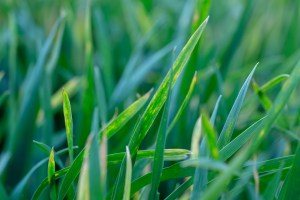
Septoria is easy to find at Callow, where varieties aren’t currently reflecting their RL rating for septoria resistance.
David also reckons Oxford looks interesting. “It’s from the same stable as Theodore and Champion but without the questionmark over specific weight, which has caused farmers in the area to avoid both varieties in spite of the other benefits they may offer,” he says.
Commenting on the septoria showing in the varieties, Jonathan says its very similar to Long Sutton, with the new leaves not yet showing any sign of infection, which will no doubt be lurking inside the leaf in its latent phase after all the wet weather during the month.
“Varieties aren’t reflecting the septoria resistance rankings in the RL, with the upper three leaves mostly clean at the moment. The degree of septoria currently is due to the leaf architecture and the rate at which the oldest leaves are dying off,” he says.
Jonathan has analysed weather data at ADAS Rosemaund and found that between 15 October and 15 November in 2022, the temperature was 2-4⁰C above average. “By the end of November we were 100 day degrees ahead of normal, which is equivalent to drilling 10 days earlier.”
Echoeing his original thoughts at Long Sutton on the RL ratings, he believes that this warm period at the backend of last year means resistance ratings (assessed on October sown wheat) should be viewed with this in mind. In effect, this means a mid-October drilled crop’s actual rating this season should be viewed as 0.5 lower than its official rating.
David reckons that this is something that he’d take into account anyway when walking the crop. Gareth agrees, saying that crops with a higher biomass are the ones likely to have higher levels of septoria infection and points out that early nitrogen has made some crops lush.
David’s clients have held off early nitrogen on the whole, even though the gound would have travelled in February. “Very few crops have needed early N. Where fertility is high, we’ve had 50-60kgN/ha sat in the crop’s canopy, so there hasn’t been a rush to get extra on.”
As to whether growers should be concerned at the septoria low down in the crop, Jonathan says there’s little benefit to be had from fungicides at T0 so he advises them to focus on T1 where yellow rust isn’t a concern.
The Crop Doctor team will be returning on 18/19 April, just before the T1 timing, to bring you the latest disease developments.
This article was taken from the latest issue of CPM. For more articles like this, subscribe here.
Sign up for Crop Production Magazine’s FREE e-newsletter here.
The post Setting up for a sea of septoria? appeared first on cpm magazine.
Continue reading on CPM website...
If you are enjoying what you read then why not considering subscribing here: http://www.cpm-magazine.co.uk/subscribe/
Download PDF
After successive years where March has seen the ground begin to dry out after the winter downpours, 2023 appears to have bucked the trend. CPM met up with the Bayer Crop Doctor team to survey sites around the country and get a feel for the possible disease challenges ahead.
By Lucy de la Pasture and Janine Adamson
The spring equinox often marks the time when winter wheat crops go into stem extension, triggering the first fungicide application of the season in crops where a T0 is merited. In 2023, above average March rainfall may have put things on hold until the ground can travel.
While that’s not a disaster in wheat crops which aren’t battling yellow rust, it has the potential to compromise the best laid fungicide plans in winter barley and oilseed rape crops.
Long Sutton, Lincolnshire

Yellow rust would normally be evident in crops by now but David Hoyles says two sharp frosts recently, which is unusual at Long Sutton, has probably helped subdue infection.
Kicking off Crop Doctor for the season saw the team visit David Hoyles’ farm at Long Sutton, Lincolnshire on 21 March. On first inspection, all plots looked much further ahead than expected given the 15 October drilling date, although perhaps not so unusual for David’s crops which tend to get away quickly in the spring.
Leading the assessment was ADAS’ Jonathan Blake, who attributes this progression to the mild autumn growers experienced. “The crop plots looks like they were drilled a fortnight earlier, and while the canopies looks healthy, there’s a lot of septoria already present on lower leaves,” he says.
“There’s a sea of inoculum across all varieties, even KWS Extase, which is commended for its resistance package. It’s not surprising given the forward nature of the plants – they’re behaving in a similar way to early drilled crops.
“We’d expect plant genetics to show through soon because varietal disease ratings are based on adult plants, not juveniles. But the severity in any given variety will also depend on the weather.”
The weather’s certainly been a challenge for David recently, who’s awaiting a dry spell and for the ground to dry up. “We had a dry December through to February, then a very wet March [equal to the sum of rainfall over the winter months], and now it looks like another fortnight of rain,” he says. “I’m hoping the crop can handle it though, given it grew up and away so quickly in the autumn.”
Diving into the specific varieties, comments continue to be septoria-themed. “Yes, a lot of septoria and also some stem-based browning, although it’s too early to identify the cause but eyespot would be a strong possibility,” comments Jonathan, while stood in a plot of Graham.
Having found septoria in every variety, it was two tiny orange-brown lesions in the Crusoe that created chatter among the Crop Doctor team. “That looks like brown rust to me, although the site is surprising clean of yellow rust,” says Jonathan.
“We’d usually see yellow rust by now but we had two sharp frosts recently, which is unusual for us and it has probably helped,” adds David.
Jonathan warns him not to become complacent. “Right now, we have perfect yellow rust conditions so although it’s been knocked back, it’s likely to bounce back too. These damp conditions will also have an impact for our current septoria problem. When we return in around four weeks, I’d expect a sea of septoria.”
Conversation soon switches to the farm’s fungicide programme. David acknowledges the need to ‘get on’ and be timely, but has struggled with continual rain. “We’ve missed T0 in some fields, but might consider a T0.5 of something relatively cheap and cheerful if we can, based on tebuconazole and a strobilurin.
“It all depends on the risk, if it’s high I’ll go with Ascra Xpro (bixafen+ fluopyram+ prothioconazole), but if not, I’ll stick with the cheaper option. The crops are looking the best they’ve looked for four years, so we don’t want disease to take over.”
Aside from fungicides, David’s also planning a PGR spray and further micronutrition, which began earlier in the season. For nitrogen, the farm’s average is 180kg/ha.
Going through the Bayer variety plots one final time, Jonathan notes the onset of mildew. “It can be an issue for varieties such as Crusoe, KWS Zyatt and Skyfall at T0. However, my main ‘watchouts’ from today are septoria and yellow rust. The mild wet autumn has promoted the septoria and current conditions are suited to yellow rust which, as this region is particularly prone, I’d expect to bounce back from the recent frosts.
“Given the autumn weather, growers will have to manage their expectations on varietal disease ratings, and knock them back by around 0.5, as these crops will be more septoria prone.”
Boghall Farm, Midlothian
Dodging heavy showers, the Scottish Crop Doctor team report septoria as the main finding in the Bayer variety demo plots at SRUC’s Boghall Farm, just outside Edinburgh.

Fiona Burnett says T1s will have to do a decent job with higher disease levels to contend with this year, but adds that it actually makes decision making easier than in a low disease pressure season.
“There are no huge differences between the 20 varieties here, all have septoria on the lower leaves with active pycnidia. But where there are differences, these are related to the growth habit and it’s the varieties with a prostrate habit that have the most septoria,” comments Prof Fiona Burnett, plant pathologist at SRUC.
“Where the leaves lie flat to the ground, the septoria is more easily spread by rain splash,” she adds.
According to Bayer’s Grant Reid, the varieties at the demo site are behind most commercial crops in the area, where septoria levels are more rampant. Fiona chimes in that the early drilling last autumn, August in places, followed by a warm autumn, a cold and dry spell early in the new year and then relentless rain through March has laid the foundations for a higher septoria season than has been seen in a number of years.
“In commercial crops, LG Illuminate stands out as a growthy variety that’s carrying high levels of septoria. There’s also stem-based browning evident this spring but whether it develops into eyespot or not, time will tell,” says Grant.
Fiona agrees that eyespot may be an issue this year. “Early drilling and the relatively warm weather we’ve had are both drivers for the disease.”
Even though the plots at Boghall are a little behind, Grant notes the varieties have a good number of tillers so the potential is there and they should soon rocket on.
In winter barley, there’s more disease evident than there has been for a few years, with rhynchosporium, net blotch and mildew all easy to find, he adds.
“When the weather improves, the pressure will be on growers to get fertiliser and early fungicides on so they’ll have to prioritise. In winter barley, the T0 timing may be missed if the ground won’t travel as crops will rush through the growth stages now.”

Some varieties are carrying higher levels of septoria than might be expected, but adult plant resistance won’t have kicked in yet.
Fiona believes it won’t be a year to scrimp on fungicides. “The expense of growing crops currently means getting disease protection on is a no brainer,” she says. “After all the March rainfall, T1s will have to do a decent job with higher disease levels to contend with this year. But it actually makes decision making easier than in a low disease pressure season.”
She advises keeping diversity in the fungicide programme – for wheat that means looking ahead at T2 and adopting different chemistry at T1. “Where there’s eyespot, there’s a good case for prothioconazole plus an SDHI at T1. Folpet inclusion also helps disease control, resistance management and adds yield.”
The OSR at Boghall has reached stem extension, getting away from pigeons which have been problematic this year, says Grant. There is also unusual levels of disease to contend with. “We’re seeing increasing levels of light leaf spot (LLS) and phoma in crops from the Borders northwards from the results of SpotCheck sampling. Thre haven’t been any real issues with pests, though slugs have been active, and crops are well rooted so will romp away.”
Fiona reckons there’s a distinct risk they could become too tall if growers aren’t mindful.
On a positive note, Grant says the moisture in the ground will help spring barley crops get away quickly and they’re unlikely to be short of water in those early weeks where tilering is so crucial. It’s also likely that pre-emergence herbicides will work well too, giving growers one less thing to worry about where annual meadowgrass is a problem, he adds.
Great Tew, Cotswolds

Jonathan Blake and Colin Woodward assess disease levels in the commercial crops at the Great Tew Estate.
At the Great Tew Estate, farm manager and agronomist, Colin Woodward, is also grounded due to the March rainfall. Like David Hoyles, the rainfall in March – 63mm to date (22 March) – equals the quantity that fell through the depths of winter.
Again, it’s septoria that’s the biggest cause for concern in the commercial crops, with visible lesions on the lower leaves of all Colin’s winter wheat varieties, even those with high resistance ratings. “The symptoms we’re seeing now are from septoria infection that would have been in its latent phase in January-February. The effect of the March rainfall will be showing up when we visit again next month.”
Walking into a crop of mid-October sown LG Skyscraper, Jonathan isn’t surprised to see the levels of septoria its carrying on the lower leaves. However, the crop of nearby KWS Palladium does raise a few eyebrows.
“Palladium is rated 7.4 for septoria resistance but its currently looking very similar to the Skyscraper we’ve just been in, with more septoria than I’d expected,” says Jonathan. Popping into another field of KWS Extase, it tells a similar tale – septoria lesions are very evident on the oldest leaves.
He goes on to explain that the AHDB Recommended List ratings are for adult plant resistance, which is assessed in June and July. “Varieties differ with how they pick up disease over the winter, during the seedling phase septoria resistance may not have kicked in.”

Stem-based browning is easy to find in KWS Extase at all the Crop Doctor sites spanning the country and at Great Tew, the lesions are found much higher on the stem (pictured).
A second field of Extase, drilled at the end of October after peas, proves to be much cleaner as far as septoria is concerned but here, stem-based browning is Jonathan’s stand out observation. “The browning is higher on the stem than I’d expect – where the fifth or sixth last leaf to emerge is dying back. Some of the lesions are penetrating,” he comments.
Also after peas and later drilled, Colin’s field of Champion is looking good and relatively clean. Nearby KWS Dawsum is standing very erect, with residual septoria in the base but very little on the last leaf emerged.
Moving into a crop of SY Kingsbarn winter barley, there’s a full house of foliar diseases in the more fertile patches, with brown rust and net blotch of most concern.
Bayer’s Ben Giles says it seems to be a net blotch year and warns growers to keep an eye on spring barley because of the danger of high seed infection levels. “It’s a disease that can prove more difficult to control now [due to fungicide insensitivity] so it’s best to used a mix of chemistry and keep rates up,” he advises.
Asked about his fungicide plans, Colin says no fungicide is planned for the winter wheat as all his varieties have an RL rating of 7 or above for yellow rust, which isn’t evident in the crop at the moment. PGRs, trace elements and herbicide, where required, will go on as a T0 at the end of March/early April.

Although there’s a full house of foliar diseases to be found on SY Kingsbarn at Great Tew, it’s net blotch and brown rust that are the primary concerns at the moment.
“If the wet weather continues then I’ll look to increase fungicides at T1. I haven’t yet decided between Aviator (bixafen+ prothioconazole) or Ascra (bixafen+fluopyram+ prothioconazole) for the Extase. Aviator has a higher loading of prothioconazole to tackle any eyespot,” he adds.
Folpet is likely be added to the T1 mix in the more disease prone varieties, such as Skyscraper, and where the barley is ‘stressy’ to aid ramularia control.
But it’s the winter barley and OSR that will take priority at Great Tew. “The Kingsbarn will have a T0 of Prosaro (prothioconzole+ tebuconazole) to help with the net blotch.”
LLS is also making an appearance in Colin’s Matrix OSR crop, and Ben notes the Bayer SpotCheck service has been seeing high incidences of LLS in samples over the past two months. Colin is planning to apply a PGR – Caryx (mepiquat-chloride+ metconazole) or Toprex (difenoconazole+ paclobutrazol) – with tebuconazole or Prosaro plus trace elements when the ground will travel, followed by prothioconazole and a strobilurin at early flowering.
Callow, Herefordshire
After 5mm of overnight rain, the heavy ground at Callow – just south of Hereford – has done a pretty good job of mopping up the 70mm that has fallen so far in the month (to 22 March). Water is sitting in the tramlines but a strong gusty wind is doing its best to dry the soil.

At Callow in Herefordshire, eyespot lesions are penetrating in places in KWS Extase.
This year the Bayer demo site is in one of the lower lying fields on the farm and developmental differences are showing up in the plots, which comprise 38 varieties and three blends, drilled 13 October, explains Bayer’s Gareth Bubb.
A quick overview of the plots reveals the most backwards looking varieties, which include RGT Grouse, LG Typhoon and LG Arkle, whereas leading the charge into spring are KWS Extase and Bamford.
Joined by Herefordshire-based independent agronomist David Lines, Jonathan heads towards ‘indicator’ varieties and finds no sign of any yellow rust on either KWS Zyatt or Skyfall, though the latter has a few spats of mildew, which may be favoured by the microclimate in this particular field, points out Jonathan.
Crusoe also disappoints, with no brown rust on the notoriously susceptible variety but septoria is easy to find in all the plots. “Theodore is the cleanest but even with its 9.1 rating for septoria, theres still some lesions on the oldest leaves, with black pynidia showing,” says Jonathan.
Extase follows the same pattern as the other sites, with more septoria than might be expected from its 7.8 rating, probably a reflection of its ‘leafy’ factor, he suggests. Eyespot lesions are also easy to find reflecting the variety’s weakness to this stem-based disease (rated 4).
Both David and Jonathan agree Palladium looks useful, a variety that Jonathan describes as a more conventional alternative to its fellow Group 2 variety, Extase, whose French parentage causes it to romp away at pace in early spring. “For its resistance to septoria (rated 7.4) and grain quality, Palladium looks like an easy swop,” he says.
David has a big acreage of Extase in the ground, with his clients favouring the septoria resistance offered by the variety in the more septoria prone region. “Although it takes off in the spring, it then seems to sit there and do nothing – it’s a bit of a hare and tortoise effect,” he says.
Jonathan feels a little more wary of Extase’s rapid tendencies, pointing out that it’s a variety that when sown early has been caught at the important flowering phase by late frosts in the past.

Septoria is easy to find at Callow, where varieties aren’t currently reflecting their RL rating for septoria resistance.
David also reckons Oxford looks interesting. “It’s from the same stable as Theodore and Champion but without the questionmark over specific weight, which has caused farmers in the area to avoid both varieties in spite of the other benefits they may offer,” he says.
Commenting on the septoria showing in the varieties, Jonathan says its very similar to Long Sutton, with the new leaves not yet showing any sign of infection, which will no doubt be lurking inside the leaf in its latent phase after all the wet weather during the month.
“Varieties aren’t reflecting the septoria resistance rankings in the RL, with the upper three leaves mostly clean at the moment. The degree of septoria currently is due to the leaf architecture and the rate at which the oldest leaves are dying off,” he says.
Jonathan has analysed weather data at ADAS Rosemaund and found that between 15 October and 15 November in 2022, the temperature was 2-4⁰C above average. “By the end of November we were 100 day degrees ahead of normal, which is equivalent to drilling 10 days earlier.”
Echoeing his original thoughts at Long Sutton on the RL ratings, he believes that this warm period at the backend of last year means resistance ratings (assessed on October sown wheat) should be viewed with this in mind. In effect, this means a mid-October drilled crop’s actual rating this season should be viewed as 0.5 lower than its official rating.
David reckons that this is something that he’d take into account anyway when walking the crop. Gareth agrees, saying that crops with a higher biomass are the ones likely to have higher levels of septoria infection and points out that early nitrogen has made some crops lush.
David’s clients have held off early nitrogen on the whole, even though the gound would have travelled in February. “Very few crops have needed early N. Where fertility is high, we’ve had 50-60kgN/ha sat in the crop’s canopy, so there hasn’t been a rush to get extra on.”
As to whether growers should be concerned at the septoria low down in the crop, Jonathan says there’s little benefit to be had from fungicides at T0 so he advises them to focus on T1 where yellow rust isn’t a concern.
The Crop Doctor team will be returning on 18/19 April, just before the T1 timing, to bring you the latest disease developments.
This article was taken from the latest issue of CPM. For more articles like this, subscribe here.
Sign up for Crop Production Magazine’s FREE e-newsletter here.
The post Setting up for a sea of septoria? appeared first on cpm magazine.
Continue reading on CPM website...
If you are enjoying what you read then why not considering subscribing here: http://www.cpm-magazine.co.uk/subscribe/





